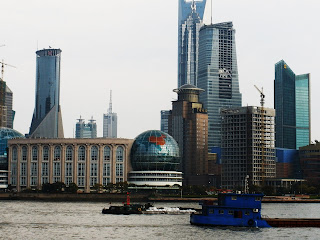

Our Japanese visit began in Kobe which is a very cosmopolitan port city which was rocked by a disastrous earthquake back in 1995 causing over 5100 deaths. It is now a sprawling modern city with skyscrapers, monorails,wonderful shopping arcades and restaurants.
We decided to be adventurous (plus we were somewhat "templed-out" having seen so many shrines and temples) so we decided to explore Mount Rokko (931 meters). We took the cable car to the top. Wonderful view of the city and the plentiful cherry blossoms which were in full bloom.
We then decided to walk down. A possible mistake !! It took us 90 "long" minutes to climb down the mountain clambering over rocks, branches of trees etc. We were amazed to meet 2 mountain bikers en route who were literally flying over the bumpy terrain. Toward the end of our climb
down we met an elderly Japanese man who was watching us gingerly manoever our way down, and very graciously offered me his walking stick. (he was at least 80 but was obviously fitter than I was!) Our next day in Kobe we wandered around the city hoping to loosen our very stiff legs.
We then had one day of sailing up to Yokohama which is a far more attractive city with numerous parks filled with tulips, very attractive buildings. Early that morning we caught the bullet train up to Toyko where my nephew - Robert - met us. That train journey was amazing not only from the speed of the train, but it is so luxurious and literally glides along the rails. Robert works and lives in Toyko so was able to give us a wonderful tour of the city. We walked around the lovely parks surrounding the Emperior's Imperial Palace. Went to the 52nd floor of
the Mori Tower Building where the view is just spectacular.
We then visited Shibuyi which is like Time Square with highly decorated neon advertisements and giant video screens and thought to be the busiest pedestrian crossing in world - (think of Time Square and multiple the number of people by at least a thousand). There are 5 or 6 roads coming into the Square, all traffic stops at the same time, and pedestrians swarm across like ants! Before going out to dinner we went to Robert's apartment which has 2-bedrooms and a great view of the city. Having been offered a "luxurious" bath I was intrigued to see Robert push a button while sitting in the lounge, enquire what temperature I'd like the bath, then sit back with a drink until we heard the sound of a buzzer which indicated my bath was ready. The huge tub was filled with water and Robert explained that this was a "wet bathroom" which meant all the overflow bath water simply drained away. The adjacent shower was completely open and again the water just drained away from the floor.The separate toilet took some getting used to with 3 buttons offering gentle music, a bidet and a blow-dryer plus a lovely warm seat. Apparently Japan spends thousands of dollars on bathroom/toilet research. They are fastidious about hygiene - even if one orders a drink at a bar, a warm towel to wash one's hands is given out.
In the evening Robert took us to a theme restaurant called "Ninja". The entire restaurant is designed in the image of a ninja house, complete with secret passageways, drawbridges, waterfalls. Food is served by a “ninja” who also performs magic tricks for diners. It was a really fun experience. (Gus's appetizer arrived with a gush of steam created by dry ice on a shrimp filled grapefruit base with a Ninja sword through it.... very different!).Two of Gus's students were at another restaurant in Tokyo and sitting at the next table was John McCain who recognized the US accents and came over and talked to them and was very interested to learn about Semester at Sea. The following morning we took the bullet train back to Yokohama and had final look around before sailing that evening. The very first impression one gets of Japan is the gracious,polite, helpful people. Although one hears little or no English, the people go out of their way to help. We experienced several occasions when people stopped to help us. It's amazing how well one can communicate with one's hands. The other very immediate thing one notices in Japan is how beautifully dressed both men and women are. All the men wear very nice dark suits with white shirts & ties and the ladies wear beautifully tailored suits and high-heeled shoes.
We would have liked to have seen Mount Fuji but there just wasn't enough time - Japan is certainly a country worth visiting for its wonderful culture and gracious people.

Gus, Sue & Robert at restaurant

Gus's steaming grapefruit/shrimp appetizer, complete with sword!



























